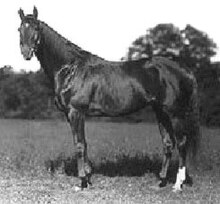Whisk Broom II
| Whisk Broom II | |
|---|---|

Whisk Broom II
|
|
| Sire | Broomstick |
| Grandsire | Ben Brush |
| Dam | Audience |
| Damsire | Sir Dixon |
| Sex | Stallion |
| Foaled | 1907 |
| Country | United States |
| Colour | Chestnut |
| Breeder | Senorita Stud Farm |
| Owner | Harry Payne Whitney |
| Trainer |
A. Jack Joyner (UK) James G. Rowe, Sr. (USA) |
| Record | 26:10-7-1 |
| Earnings | $37,931 |
| Major wins | |
|
Select Stakes (1910) Trial Stakes (1910) Victoria Cup Handicap (1912) Metropolitan Handicap (1913) Brooklyn Handicap (1913) Suburban Handicap (1913) |
|
| Awards | |
|
1st New York Handicap Triple Crown Champion (1913) Retrospective U.S. Champion Older Male Horse (1913) Retrospective United States Horse of the Year (1913) |
|
| Honours | |
| United States Racing Hall of Fame (1979) | |
Whisk Broom II (1907–1928) was an American-bred Thoroughbred racehorse who raced in the United Kingdom (under the name Whisk Broom) and in the United States. Whisk Broom showed high class form during four seasons of racing in Europe, but produced his best performances when returning to America in 1913. He claimed the New York Handicap Triple by winning the Metropolitan Handicap, the Brooklyn Handicap, and the Suburban Handicap, a feat unmatched until Tom Fool achieved it forty years later. Kelso in 1961 and Fit To Fight in 1984 later joined them as the only other horses to win the Handicap Triple. Whisk Broom II's career was ended by injury after his triple success, but he went on to become a successful breeding stallion.
A grandson of Ben Brush, Whisk Broom II was sired by the U.S. Hall of Fame stallion Broomstick. He was bred in 1907 by the late Sam S. Brown's Senorita Stud Farm (now the site of the Kentucky Horse Park). In 1908 New York State passed the Hart-Agnew Law, which made betting on horse racing illegal, and led to the closure of many racetracks. Several prominent owners moved the bulk of their operations overseas, with Europe being a popular destination. Harry Payne Whitney, who had purchased Whisk Broom, sent the colt to England to be trained by the American Jack Joyner.
Whisk Broom was one of the best British-trained two-year-old of 1909. On his second start he earned his first win in the Prince of Wales Plate at York Racecourse, but he showed his best form in autumn at Newmarket, when he finished second to the future Epsom Derby winner Lemberg in two of the season's most important tests for juveniles, the Middle Park Stakes and the Dewhurst Stakes. In the former race he finished a neck behind the future English champion after running "very tenaciously". At the end of the year, he was rated the equal third-best two-year-old colt in England behind Neil Gow and Lemberg.
...
Wikipedia
